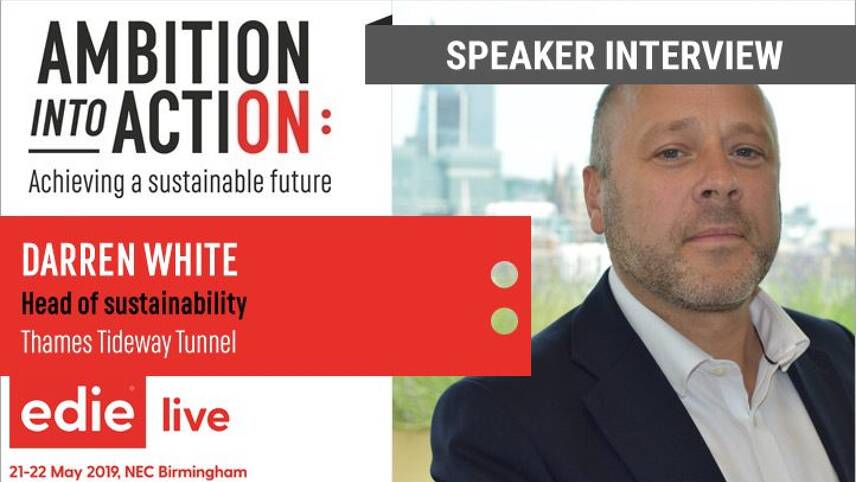Register for free and continue reading
Join our growing army of changemakers and get unlimited access to our premium content

£1.4bn of the financing for Tideway's £4.3bn 'super sewer' project is accounted for by green bonds
In 2015, London’s ‘super sewer’ project was already most of the way through its ten-year planning stage. Developers had spent years conducting extensive meetings with stakeholders ranging from local authorities to international investors and local residents to inform the project’s 45-point legacy plan – a sweeping long-term sustainability strategy covering health and safety, wellbeing, economic benefits, people and places and the environment.
Shortly after this strategy was released, plans for the project took a step closer to becoming reality with the formation of the project’s official company, Tideway. And soon after this, world leaders gathered at a UN summit developed the SDGs – a set of 17 global ambitions aimed at uniting stakeholders across the globe in fostering a more environmentally, socially and economically sustainable future for all.
Noticing that SDG 6 (Clean Water and Sanitation) was the company’s reason for being, Tideway’s sustainability team conducted an internal mapping exercise to determine how its legacy plan targets could be aligned with the framework of the 17 Global Goals shortly after their public launch in January 2016.
Tideway’s head of sustainability Darren White maintains that this move “helped to bring structure and credibility” to the firm’s legacy targets but told edie that even bigger benefits had been reaped since it decided to communicate the SDGs with external stakeholders – starting with investors. The £4.3bn project is notably financed entirely through private funding, with £1.4bn raised through green bonds and the remained accounted for by the European Investment Bank and Thames Water.
“We were always hoping to reference the SDGs in our annual report [to investors], but we wanted to do this in a big way and state, in our green bond framework, which Global Goals targets we believe we can play a part in,” White said.
“In this way, we used what had previously been an internal exercise in a public-facing document for the first time – and when we first went to the market with it, we got offered £890m within two hours, when we were aiming for £250m. We had originally been set on issuing regular bonds, but green bonds are seen as much more secure bets by private investors.”
A boon for green bonds
The development of Tideway’s green bond scheme was jointly overseen by its sustainability and treasury team, with the product framework being independently assessed by S&P Global Ratings before it went to market.
Amid warnings that the next financial crash is likely to be climate-related, investors are increasingly divesting from high-carbon projects and seeking to “green” their portfolios, aligning them either with the Paris Agreement or the SDGs.
The market for green bonds is, therefore, booming. It grew by a staggering 78% between 2016 and 2017, with national and institutional investors funnelling more than $150bn into low-carbon projects, and, since then, the likes of Starbucks, Verizon and Bank Of America have each issued more than $1bn of green bonds.
Action against ‘SDG-washing’
Shedding more light on how Tideway determined its SDG alignment approach for its green bonds, White explained that the company had undertaken a materiality assessment to identify the goals against which it could have the most impact – namely SDG 6, Clean Water and Sanitation, and SDG 11, Sustainable Cities and Communities. SDGs 9, Industry, Innovation and Infrastructure; 5, Gender Equality; 8, Decent Work and Economic Growth; 12, Responsible Production and Consumption and 13, Climate Action were also identified as secondary areas in which the company could “significantly” contribute.
This exercise, White claims, enabled Tideway to avoid “SDG washing” – a term used to describe the act of placing graphics related to all 17 of the Global Goals on communications materials, regardless of whether the firm is making an impact which aligns with the UN’s vision.
“It’s great to see how businesses have started to embrace the SDGs, but I get concerned when organisations come out and say they are solving all 17 of them – it just looks like they haven’t been embedded as a key part of the business or used as a proper tool,” he said.
“I’ve seen companies set really weak targets and badge them up as their commitment to an SDG, when they are not as ambitious as the framework set by the UN. They’ve been used as a branding exercise, while we wanted to show that they are a core consideration.”
White’s comments come amidst a string of studies suggesting that holisitc and meaningful SDG alignment is still a challenge for corporates, even though more than 10,000 companies have pledged their support to the framework. Recent research by KPMG, for example, found that companies are still struggling to achieve boardroom buy-in for action on them due to a lack of available metrics for tracking progress against their aims. Similarly, PwC has found that two-fifths of businesses are still failing to engage meaningfully with the Global Goals.
The SDGs at edie Live 2019
The Sustainable Development Goals are taking centre stage at the UK’s largest sustainability and energy exhibition this year, with an entire Theatre and day dedicated to the topic at edie Live on 21-22 May.
The two-day show – edie’s biggest event of the year – has become a highlight of the calendar for sustainability, energy and environment professionals looking for new ideas and solutions that will help them achieve a low-carbon, resource efficient and profitable future for their business.
Register for your free edie Live 2019 pass here.
Sarah George


Please login or Register to leave a comment.